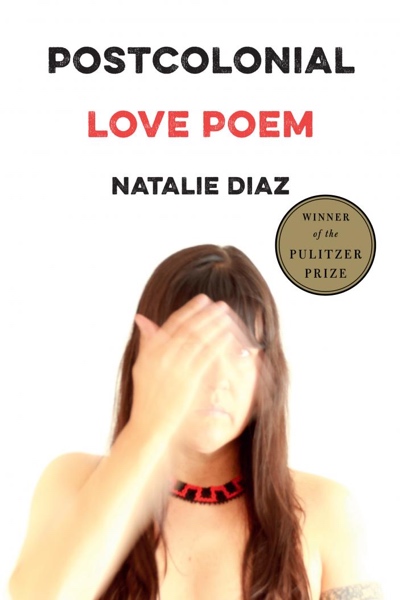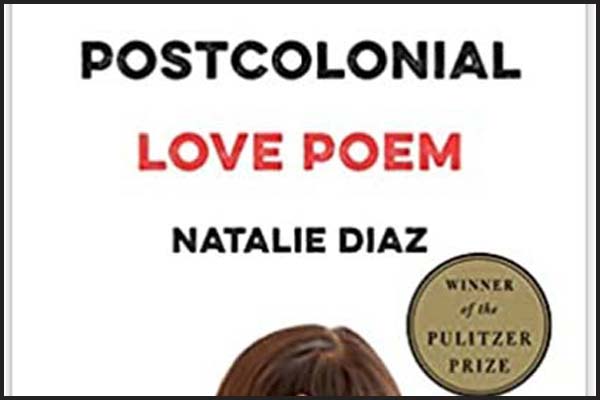A Pulitzer Prize–Winning Collection
By Sara London, Poetry Editor
Postcolonial Love Poem by Natalie Diaz (Minneapolis: Gray Wolf Press, March 3, 2020; 120pp; $16.00; ISBN 978-1-64445-014-7).
 Natalie Diaz’s second collection, winner of this year’s Pulitzer Prize for poetry, is a raw and exuberant evocation of rage, resistance, and desire. The ‘want’ that is waged here, however, is not just a quest to assuage the yearning human heart. Diaz’s hunger is for deep approbation and healing—for the kind of recovery history has denied America’s Native People. In the title poem that opens the book, Diaz, a MacArthur Award recipient who is Mojavi and a member of the Gila River Indian Tribe, writes of the “ever-blooming wounds” of wars waged against Native Americans. “I was built by wage,” she says, “So I wage love and worse…”
Natalie Diaz’s second collection, winner of this year’s Pulitzer Prize for poetry, is a raw and exuberant evocation of rage, resistance, and desire. The ‘want’ that is waged here, however, is not just a quest to assuage the yearning human heart. Diaz’s hunger is for deep approbation and healing—for the kind of recovery history has denied America’s Native People. In the title poem that opens the book, Diaz, a MacArthur Award recipient who is Mojavi and a member of the Gila River Indian Tribe, writes of the “ever-blooming wounds” of wars waged against Native Americans. “I was built by wage,” she says, “So I wage love and worse…”
Many of the motifs and uniquely ‘living’ metaphors in her collection are imbedded in this striking prefatory poem in which desert seeds, dormant as geodes, sometimes for twenty years, awaken when a flash flood “bolts the arroyo, lifting them / in its copper current, opens them with memory…” Creation itself and its myths are defining themes for Diaz, and the birth of the self is a perpetual unraveling odyssey in these poems.
“Desert” and “river” compose this poet’s very blood and bones as she grapples with ideas of what it means to be an American. In the vivid and heartbreaking poem “That Which Cannot Be Stilled,” the speaker reflects on the epithet “Dirty Indian”:
All my life I’ve been working,
………To get clean—to be clean is to be good, in America.
…………………To be clean is the grind.
Except my desert is made of sand, my skin
………the color of sand. It gets everywhere.
America is the condition—of the blood and of the rivers,
of what we can spill and who we can spill it from.
………A dream they call it, what is American.
The recurring dream Diaz goes on to describe features a dunescape “on the edge of the rez,” from which erupts a mass of “tangled rebar, torn fences scrambled, / sheet metal, oxidized and spiking…” This nightmarish “junk” breaks through “the sand like it’s my own skin,” unleashing an unstoppable “rising wild” within. The vision has no discernible pattern that her cultural traditions recognize in dreams, it’s “just land and its moving” — another of the uneasy displacements these poems powerfully evoke.
Wildness pulses through many of the poems, at times as voracious sexual appetite memorably rendered with fresh figurative vividness. In “Wolf-OR-7,” a wolf (returning twenty-seven years after its species has been hunted to oblivion) merges with a human lover in a sensual, unfolding narrative: “In the tourmaline dusk I go a same wilding path, / pulled by night’s map into the forests and dunes of your hips…” Diaz renders a natural yet hauntingly magical lust: “I broke open my mouth upon yours // as we pressed against the glass doors of the cliff house / looking out into the bay’s shadows hammering // the bronzed bell of the supermoon.”
Violence, too, is a hotly living presence. In poems about familial damage, Diaz provides an open, clear-eyed accounting: “My brother has a knife in his hand / He has decided to stab my father…” reads the opening of “Blood-Light,” the book’s second poem. But we also glimpse the emotional armor of irony, as in “Catching Copper,” in which an animated bullet is leashed like a dog. “My brothers lose / their bullet all the time— / when their bullet takes off on them / their bullet leaves a hole.”
The book’s layered tonal shifts deliver additionally revealing insights in poems about basketball (a sport the poet once played professionally). “On the court is the one place we will never be hungry—that net is an emptiness we can fill up all day long,” she writes in “Top Ten Reasons Indians are Good at Basketball.” A basketball has “never been just a basketball,” she claims:
It has always been a fat gourd we sing to, the left breast of a Mojave woman
three Budweisers into Saturday night. It will always be a slick bright bullet we
can sling from the 3-point arc with 5 seconds left on a clock in the year 1492…
These are poems that reverberate with hard truths about the legacy of white American violence and oppression; but Diaz’s grief also extends beyond personal and cultural wounds to the harm done to earth’s precious resources. The poem “exhibits from the American Water Museum,” is pointedly organized as a random showcase of everything from the failures of Flint, Michigan to a US company’s absurd claims to foreign water. For Diaz, the affliction is all encompassing: What’s done to the human body and heart, and our species’ destruction of the natural world, are one and the same. After all, water is the life blood: “I am fluent in water. Water is fluent in my body— / it spoke my body into existence.” The origin story she recounts conjures a primary “joy,” when “the Creator pressed his staff / into the earth, and the earth opened…” It’s a striking image of beginnings: “Out of this opening leaped earth’s most radical bloom: our people— // we blossoms from the original body: water…”
Intricate emotional currents drive these poems. But Diaz’s lyrical vision is engined by a multifarious fluency of mind. She toggles between languages, “Makav” or “Español,” and expertly navigates the lexicons of Mojavi and Greek myths. Words are virtually held and turned like desert minerals prized for flashes of uncommon light. This is a writer mourning and loving hard in poems of inspiring originality and propulsive urgency.
Read more poetry collection reviews here.
Copyright 2021 Woven Tale Press LLC. All Rights Reserved

